Rainbow Trout and Steelhead The Same Species?
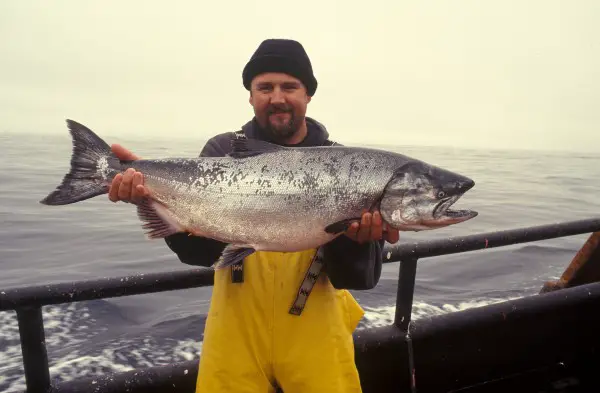
Are you looking into how to tell a rainbow trout and steelhead trout apart? Fish recognition helps fishermen and outdoor enthusiasts identify protected or even invasive species. Sometimes protected or endangered fish carry special laws or fines if fished for improperly. If you plan on spending a lot of time fishing for trout, you’ll likely be faced with this question: Rainbow trout or steelhead? But what’s the difference?
The rainbow trout and the steelhead trout are essentially the same species, but the main difference is their lifestyles. The steelhead is anadromous and spend the majority of their life in saltwater sea bodies before moving to rivers for reproduction purposes. On the other hand, rainbow trout are primarily freshwater fish. Once you understand the core differences between rainbow trout vs steelhead, you will understand the significant differences in their color, size, meat quality, and taste.
Rainbow trout and steelhead are ray-finned fishes and belong to the salmon family. While both of these fish belong to the same primary species, certain lifestyle changes influence the taste and quality of meat obtained from these top sport fish.
Once you understand the core differences between rainbow trout vs steelhead, you will be able to understand which one you want to hunt for yourself and why.
What Are the Differences in Lifecycles Between Rainbow Trout and Steelhead?
The primary species for both of these fish is Oncorhynchus mykiss. This means that both of these fish start their life in the same manner. They hatch out of eggs in freshwater bodies, such as:
- Streams
- Lakes
- Rivers
However, rainbow trout do not feel the need to migrate to other water bodies and spend the majority of their lives in the same body of water that they are born in.
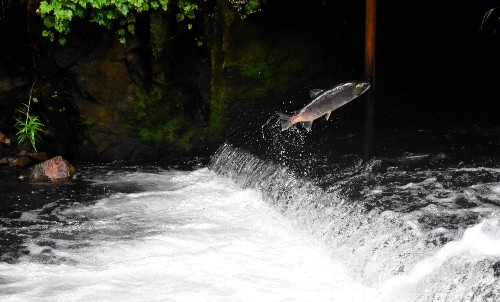
On the other hand, steelhead fish quickly migrate to the sea and spend the majority of their lifecycle in the sea before moving to a smaller water body, such as a river according to biologicaldiversity.org*.
Rainbow trout will start laying eggs and spawning within the first two years of their life. Moreover, these fish can also range from 1 pound to 10 pounds in size over the course of years.
At the same time, steelhead fish can grow up to 20 pounds in size and weigh more than an average rainbow trout.
Steelheads have been given the nickname ‘fish of a thousand casts’ because they are so difficult to catch!
Scientists still don’t understand why steelhead migrates to saltwater ocean and sea.
According to some experts, it may be an impact of environmental conditions, but steelheads can stay in the saltwater body of water for up to 5 years.
How to Distinguish Between the Two Fish?
While there are negligible differences between the two fish species, some subtle elements can help you distinguish the difference between rainbow trout and steelhead.
Therefore, as an angler, you need to understand these differences to determine the kind of trout you want to hunt.
The Size
One of the major differences between rainbow trout and steelhead is the size difference between the two.
Rainbow trout fish fall under the same category when it comes to their sizes and colors.
In comparison, steelhead fish are bigger than rainbow trout and actually have three distinct groups and categories according to their sizes.
One-Salt, also known as Half Pounders, are those steelhead fish that have already spent an entire year in the saltwater sea or ocean.
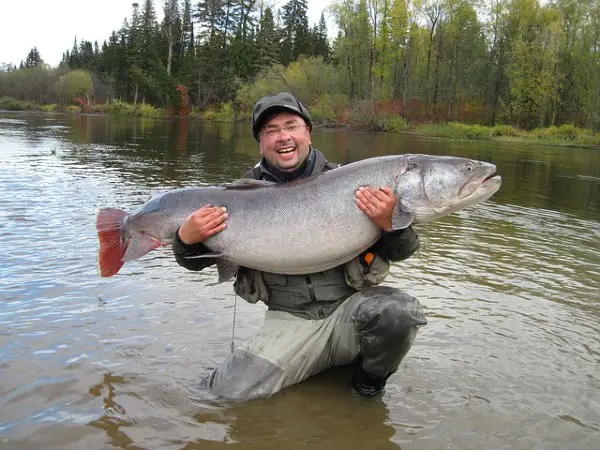
These may be known as half-pounders, but these often weigh around 2 pounds to 6 pounds. These fish are known to stay close to the coastline and rarely go out to the open ocean. These are the most similar to rainbow trout in size, color and lifecycle attributes.
On the other hand, Two-Salt steelhead spends around two years in the ocean and go into the open ocean. These may weight up to 10 pounds when they finally return to their natural habitat.
Lastly, the steelhead fish that spend the most time in the ocean is known as Three-, Four-, and Five-Salt by fishers.
On average, these fish may weigh as much as 30 pounds and can be quite heavy. These fish spend around five years in the ocean before they finally make it back to their natural freshwater habitat.
The Scars
Growing up to remarkable sizes is pretty common among the two cousin trout fish.
Growth rate to huge sizes requires a lot of time, which results in wear on the scales of these fish. This is yet another major difference between rainbow trout and steelhead.
When understanding rainbow trout steelhead differences, you will need to take a look at the general amount of scars on the body of these fish.
Steelhead trout fish have more scars on the body due to the daily wear and tear of the rugged saltwater ocean.
On the other hand, rainbow trout mostly live in freshwater and calm water bodies and come with fewer scars on the scales.
The Color
This is another major rainbow trout steelhead difference. Steelhead fish often comes with a brighter color palette on their scales compared to freshwater rainbow trout fish.
Moreover, steelhead fish are also known for a brilliant silver color sheen on their scales. You can easily identify a steelhead from a rainbow trout by looking at the silver sheen.
Another significant element for identifying the rainbow trout steelhead salmon difference is the reddish stripe found among the steelhead trout.
These fish develop a reddish stripe that runs along their body, and rainbow trout fish have a cleaner and smoother outlook and a gentler reddish stripe.
The Spawning Cycle
As we have already discussed, steelhead trout only returns to freshwater habitats for reproduction and spawning.
This is one of the major rainbow trout steelhead differences, and this is why you need to look for the signs of breeding in the trout that you catch during your next hunting trip.
During the spawning cycle, the colors are brighter on steelhead fish, and the male steelhead trout can develop a hook in their lower jaw.
This hook is also known as “kype.” When it comes to females, they will have softer bellies filled with eggs and will also have a brighter silver sheen on their scales.
This is how you can differentiate between a steelhead trout and a rainbow trout.
Is The Rainbow Trout Endangered or Protected?
According to the experts at the US Fish and Wildlife Service*, the rainbow trout is not endangered. Likewise in some regions the rainbow trout is protected in order to prevent the spread of Whirling disease.
Whirling disease is a significant threat to trout fisheries.
This disease originates from a tiny microscopic parasite that mainly affects trout and salmon species raised in hatcheries.
It’s causes a curved spine deformity and can result in killing the majority of young fingerling trout.
First noticed several decades ago, it remains a problem to this day.
Is The Steelhead Endangered or Protected?
The professionals at NOAA Fisheries** state, “One distinct population segment is listed as endangered under the Endangered Species Act, and 10 DPS and 1 experimental non-essential population are listed as threatened.”
What Is the Diet for Steelhead and Rainbow Trout?
When understanding the rainbow trout steelhead salmon difference, you will need to look at the diet pattern for the two.
Since steelhead trout can weigh up to 30 pounds in size, you can easily understand that there is a significant rainbow trout steelhead salmon difference when it comes to the diet routine for the two trout cousins.
As we have already discussed, steelhead fish can grow up to 30 pounds in size, and this is why you can understand that this fish must have a better and a higher diet routine then its cousin, rainbow trout.
When steelhead trout gets to the ocean, it starts consuming as much food as it can and starts packing on the pounds.
The reason behind this is the rich ecosystem of the saltwater ocean that offered a wide variety of different food and meal options to steelhead trout fish.
In general, steelhead fish consumes smaller saltwater fish, sardines, and herrings. Other than that, steelhead fish can also consume:
- Squid
- Shrimp
- Crabs
- Crustaceans
- Mollusks
- Zooplankton
This rich diet allows steelhead trout fish to grow up to 30 pounds during their time in the ocean.
Rainbow trout only consume what is available in freshwater streams and as a result are significantly smaller in size. This diet routine is an elemental difference between the rainbow trout steelhead salmon cousins.
Rainbow trout fish can consume:
- Fish eggs
- Small fish
- Crustaceans
- Mollusks
- Aquatic Insects (mayflies, caddisflies, midges, etc.)
- Nymphs
- Gobies
- Minnows
- Shiners
- Sunfish
When understanding the difference between the rainbow trout steelhead salmon cousins, you need to understand that the reason behind the different sizes for the cousins of the same species is the varied diet routine and availability of food.
Rainbow trout fish has to live primarily on the smaller larval insects and fish found in freshwater streams, whereas its cousin steelhead trout can east anything in the ocean and grow up to remarkable sizes.
Where to Catch Rainbow Trout and Steelhead?
Both of these fish are actually native to North America west of the Rockies.
Over the past few decades, their immense popularity led to the introduction of these fish into every other state in the United States of America and the rest of the continents as well.
The only continent that doesn’t have any rainbow trout is steelhead trout is Antarctica.
You will find these fish in all the freshwater streams, such as rivers and lakes, during their early months.
One of the best and easiest ways to catch a trout is by trolling in a boat, kayak, or canoe.
Read more: How To Troll for Trout [A Beginner’s Guide]
In addition, if you are looking to fish for mature steelhead trout fish, you will need to head to the coastline of the Pacific Ocean or saltwater bodies near the coastline. That is where you will find mature steelhead fish.
You can easily find rainbow trout fish in any freshwater body, and use the non-fly or fly fishing technique to catch one of these beautiful beasts for your next dinner.
How to Catch Rainbow Trout and Steelhead?
You may be wondering that since both of these fish belong to the same animal class and species, the method for catching these will also be the same.
Surprisingly, this is completely false. Both of these fish require a different method for hunting and catching.
You will mostly find steelhead trout fish during the winter months when it is trying to migrate to freshwater habitats for a spawning cycle.
When steelhead fish reach the maximum weight size their instinct triggers it to return to its natural freshwater habitat for spawning.
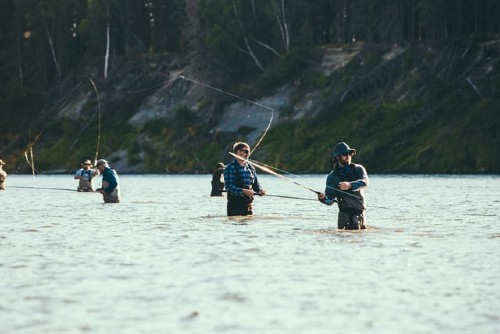
By the way, at this time the majority of anglers try to catch their favorite steelhead trout fish.
As we already know that steelhead fish can reach up to 30 pounds, so you can automatically assume that you will require a larger and more powerful rod to catch this gigantic fish.
The majority of hunters and anglers use two-handed rods for swinging large flies over the surface of the ocean. Once the steelhead trout fish sees these flies, they jump out of the ocean and fly towards the bait.
A two-handed rod can easily help you pull in the extra 30 pounds of trout into your boat. Moreover, anglers also use a nymph and an indicator rig to catch steelhead trout fish during the fly fishing season.
You can also use non fly fishing techniques for steelhead, but you will always require a powerful two-handed rod for this gigantic fish.
If you are thinking of catching some rainbow trout fish for your next dinner party, you can easily use a lighter rod since these fish rarely cross 6 pounds. Moreover, rainbow trout live in freshwater streams and offers minimum resistance against the pull from fishers.
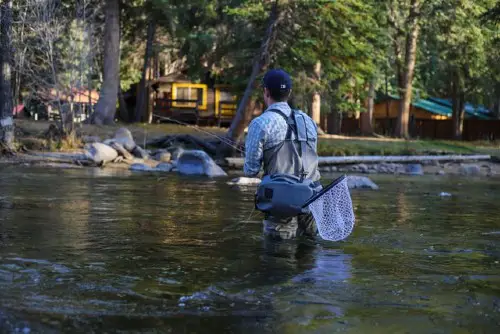
A lighter fishing rod can not only handle the weight of a rainbow trout but also bring it to the boat without any problems.
The majority of anglers opt for a five weight rod for catching rainbow trout during the fishing season.
Rainbow trout fish living in any freshwater stream in the world and can use the fly fishing technique with a lighter fishing rod to bait, hunt, and catch these fish.
Steelhead Vs Rainbow Trout Flavor

Some subtle differences might influence your next fishing trip when it comes to rainbow trout vs steelhead taste. The difference in rainbow trout vs steelhead taste will encourage you to choose the right trout cousin for yourself. Let’s take a look.
When it comes to steelhead trout fish, these fish taste quite similar to the wild salmon found in saltwater water bodies. Since these fish feed on the same meal and diet as a wild salmon, the Pacific Ocean batfish, the steelhead fish develop a salmon-ish orange-red hue in their meat. This hue also influences the taste of the meat. The high amount of krill found in batfish results in superfood properties for steelhead trout fish.
This similar diet plan results in a wild salmon-like taste in wild steelhead trout fish found in the saltwater ocean bodies.
However, farm-raised or Great Lakes steelhead fish will offer a different taste to the audiences. Since these fish are raised in controlled environments with a different diet routine and water quality than the ocean, there is a gentle trout-like taste to these fish.
The taste for the famed or Great Lakes steelhead fish is generally milder than the wild ones and offers a completely different nutritional profile. This is due to the water quality of the habitat and inorganic food supplied to these fish.
When determining the difference between rainbow trout vs steelhead taste, you should understand that rainbow trout offers a milder flavor and taste as compared to its saltwater cousin. The meat comes with a white hue on the surface and is quite soft and flaky due to the freshwater habitats.
The meat is softer than other saltwater fish and doesn’t contain any visible blood lines or veins on the surface. This is why it doesn’t offer a stringent fishy flavor as the majority of wild fish do. It is perfect for those who want to enjoy the fish’s nutritional profile without having to deal with the strong smell of fish meat.
Can You Eat Trout Eggs?
The short answer is Yes. You can easily consume trout eggs. Moreover, these eggs are considered a delicacy in some regions and are presented as caviar.
Can Rainbow Trout Become Steelhead?
Yes. Steelheads trout fish are basically the ocean-going version of the ordinary rainbow trout fish. While biologists have yet to figure out the true cause behind this migration, but the rainbow trout that migrate towards the ocean become steelhead in the long run. The rainbow trout fish that exhibits an anadromous life cycle becomes a “steelhead” trout fish.
Where Can I Buy Rainbow or Steelhead Trout?
Rainbow and steelhead trout are sold everywhere in the world. You can purchase both of these fish at your local supermarket, or you can also contact the local fish farming agencies and have these fish delivered to your doorstep.
These fish are sold in different forms, such as fillet, whole-fish, and chopped meat. You can have the entire fish delivered to your home or visit the local supermarket or fish farm to buy them according to your preferences.
If you want to buy some fresh, wild-caught steelhead trout you can click here for more information.
What Is the Bottom Line Here?
I have tasted both of these fish, and let me tell you something; it was incredible every time.
When I first had my hands on a gorgeous rainbow trout, I couldn’t wait to slice it open and cook it. It offered a mild yet delicious taste.
On the other hand, my experience with the steelhead trout was slightly different as it offered a wild salmon-like flavor with a unique hint of trout in the mix. It was brilliant.
I have been fishing for over a decade now, and catching a 20-pound steelhead trout still gives me a rush.
I used a two-handed rod to dangle flies on the surface, and these fish jump out of the surface to hook themselves on to the bait.
If you are also looking to fish for steelhead trout or rainbow trout, you can visit North America or check with the local rivers and streams to see if they also have them.
Other Trout Trolling Related Articles Just For You...
- How To Troll for Trout [A Beginner’s Guide]
- 10 of the Best Trolling for Rainbow Trout Techniques [Tips Without Downriggers]
- Trolling for Trout with Downriggers (Best Practices & More – Secrets From A Retired Fishing Guide)
- How To Troll Flies For Trout [Our 15 Best Tips]
- What’s The Difference Between Rainbow Trout Vs Steelhead?
George Servinson
My name is George and I'm been fishing my entire life and love all things outdoors. My passion is helping anyone catch more fish. The newest things I've been doing lately is learning how to break down and clean all my reels, teaching my boy how to kayak fish, and bushcraft wilderness survival.